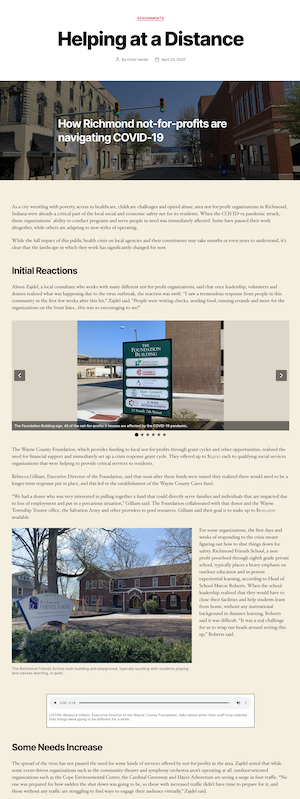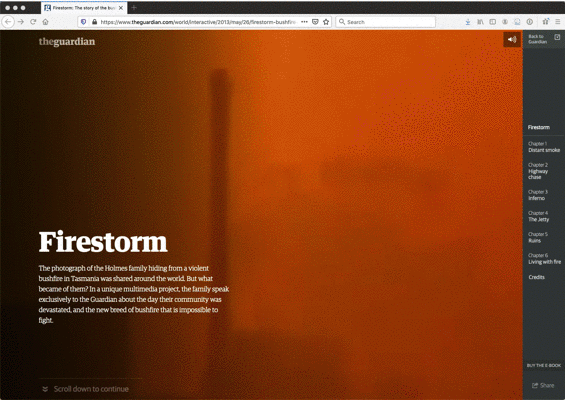I recently finished a really interesting course in my graduate journalism studies program, focused on cross-platform, multimedia storytelling. It was fun in part because it wove together a lot creative disciplines I had already been experimenting with, including writing, photography, audio production, video production, interviewing people, and assembling the results of those efforts into a coherent, interesting final product that would engage the attention of readers and visitors. I got academic credit for doing things I love to do — nice!
It was also an experience that opened my eyes further to the power of the WordPress block editor for multi-media journalism and storytelling, and I want to share a bit more about that.
(If you're not already familiar with it, the WordPress block editor, also known as Gutenberg, is the updated content editing experience introduced into the WordPress publishing platform back in 2018. It transitions content authoring and editing in WordPress from a fairly linear "title plus paragraphs of text plus maybe some images" workflow into a much more flexible and powerful workflow that can include a wide variety of multi-media, interactive elements positioned throughout the body of a page or article. If you were talking to someone using a few tin cans and some string before, now you're enjoying the wonders of a smartphone.)
Like others I've had some skepticism in the past about the block editor and its place in the world of everyday WordPress users who may not want the additional power it offers. And at a personal level, old habits can die hard; I found myself writing this very post in the "classic" editor because it's how I've mostly always done things. So I haven't always been sure when and were I could definitively say to others that the block editor would be an essential part of their publishing toolkit.

But in this journalism class, the use case quickly became clear.
As we talked about how so much of modern journalism is about finding some kind of multimedia hook that will draw readers into a piece — a compelling photo, a moving video, a bit of audio that gets them interested, a snappy lede shared on social media — I thought about how important it is to make sure the underlying publishing tools you use support that kind of production work.
As a class when we were tasked with setting up dedicated websites for publishing our assignments, I saw how quickly and easily the other students who chose WordPress were able to create some really engaging pieces using the built-in "blocks" offered by the new block editor.
And as I put together my own final assignment, a multi-media story about how the not-for-profit organizations in my city were responding to and handling the COVID-19 crisis, I really enjoyed exploring the flexibility of what the block editor could do. I was able to create an article with audio, an infographic, a photo gallery, some fancy bits of layout and more, all inside of the editing experience provided by WordPress.
In the past, pre-block editor, this kind of creativity would have required some combination of design/production work outside of WordPress, use of proprietary add-on tools, or custom theme, plugin or other software development to power these multi-media experiences. Now, so much of it can happen in one place. That's an amazing leap forward for journalists and publishers everywhere.
 Still, as we looked at some multi-media journalism pieces from recent years that were created without WordPress or the block editor, I found myself excited and a daydreaming about how the block editor and related tools could take multi-media journalism production even further. If you look at Firestorm from The Guardian or The 45-minute mystery of Freddie Gray's death from The Baltimore Sun or What is Code? from Bloomberg or The New York Times` interactive exploration of the fire at Notre-Dame and the richness that each of these pieces offers, you can see that there are still some great opportunities for WordPress to better facilitate the production of interactive storytelling.
Still, as we looked at some multi-media journalism pieces from recent years that were created without WordPress or the block editor, I found myself excited and a daydreaming about how the block editor and related tools could take multi-media journalism production even further. If you look at Firestorm from The Guardian or The 45-minute mystery of Freddie Gray's death from The Baltimore Sun or What is Code? from Bloomberg or The New York Times` interactive exploration of the fire at Notre-Dame and the richness that each of these pieces offers, you can see that there are still some great opportunities for WordPress to better facilitate the production of interactive storytelling.
Those four pieces undoubtedly required some non-trivial custom development of publishing tools, templates and website functionality modules to bring the media together in a coherent way. But there are also some common elements we can notice: advancing the telling of the story through a user's scrolling behavior, having key milestones where the story pauses to allow the reader to go off in a new direction or focus in on some detail, and the use of interactive elements where the reader can control something that unveils or reinforces information about the story's subject.
These bits of functionality and navigation tools seem closer than ever to what WordPress and its block editor could offer "off the shelf." A few years ago we were maybe 10 or 20% of the way there. Today I'm guessing we're more like 75 or 80% of the way there. Pretty impressive progress.
Of course, I'm far from the first person to think about these possibilities. The folks behind the Aesop Story Engine project have been offering WordPress tools for multimedia storytelling since before the block editor was available. There are tutorials like this one from Yoast on how to use different blocks to tell stories more interactively. And the folks working on the Newspack project are already showcasing the power of WordPress to transform how publishers design and present their content.
What does feel more present, maybe even urgent, to me right now is that compelling storytelling and multimedia journalism, where readers and news consumers can quickly place themselves in the story and understand its importance in the broader world, seems more critical than ever for civic engagement. 700 words of printed text about the way a virus can be transmitted at a restaurant buffet might hold the attention of some, but coupled with some video, infographics and photos that offer a number of different ways in to the story, I suspect far more people have a chance of engaging with it. Maybe it could even save lives.
Not every story is life-and-death and there are plenty of other challenges to journalism out there, but giving publishers and journalists (and students and bloggers and business owners!) the tools to not only tell but also show readers why a story should matter to them is something we really need right now. I'm so proud of what WordPress has done and is doing there. As the tools mature and as even more possibilities emerge, I think we'll continue to see some amazing stories being told in even more amazing ways.
 I’m a journalist, publisher, software developer and entrepreneur with experience as a founder and organizational leader. Work with me or learn more about me.
I’m a journalist, publisher, software developer and entrepreneur with experience as a founder and organizational leader. Work with me or learn more about me.